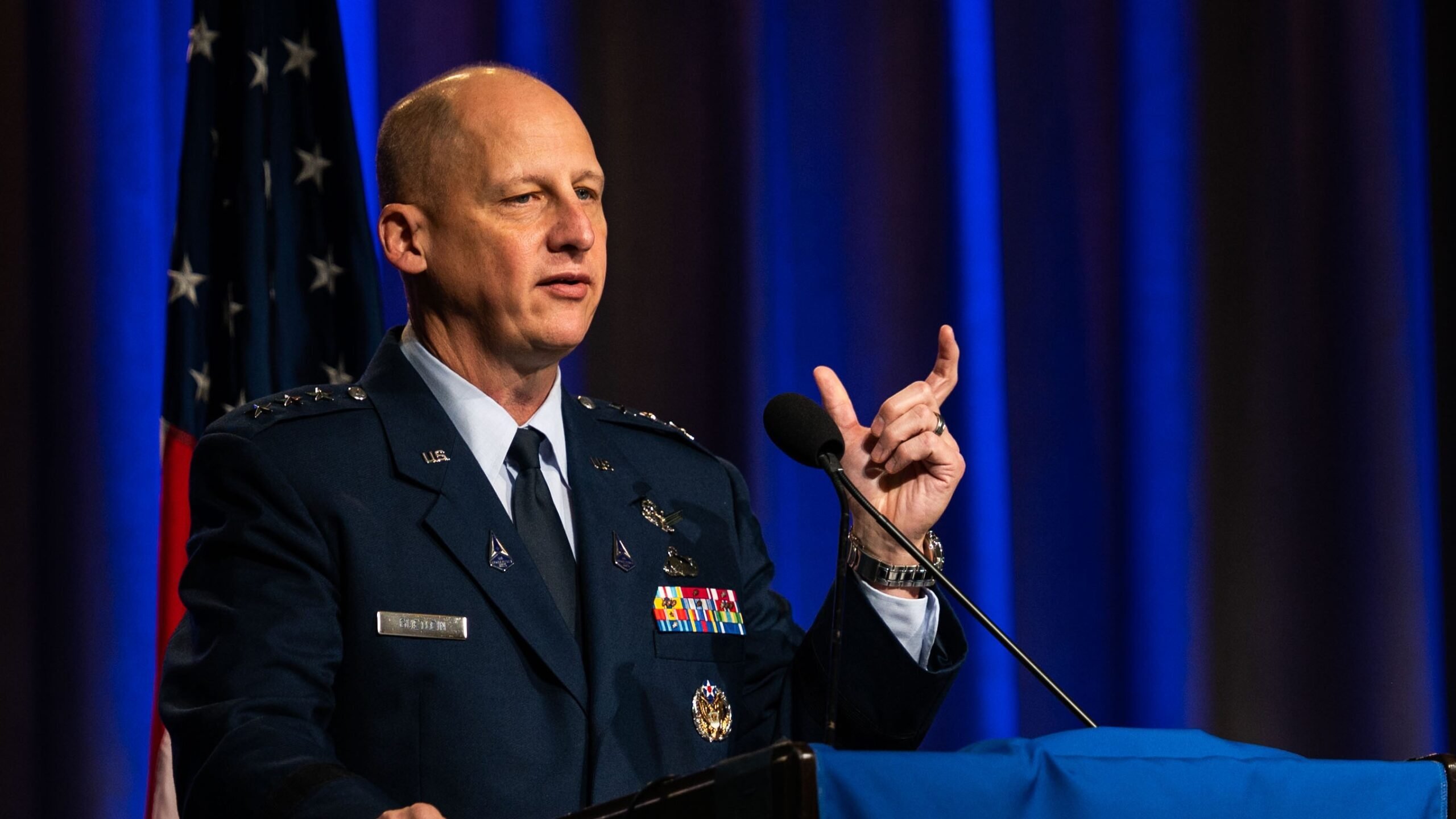
Space Force Lt. Gen. Michael A. Guetlein, Space Systems Command commander. (U.S. Space Force/Luke Kitterman)
WASHINGTON: The new(ish) Program Integration Council (PIC) scored a victory in the run up to the Defense Department’s fiscal 2024 budget request, for the first time coordinating the five-year planning documents for future space acquisition among its interagency members, the head of Space Force’s acquisition command said on Wednesday.
And while this may sound like boring budgetary geekery, it is a major bureaucratic muscle movement that will help the Pentagon to get a grip on streamlining national security space acquisition — an issue of deep concern in Congress and one of the driving forces behind the creation of the Space Force in the first place. And it will be music to the ears of many on Capitol Hill.
Lt. Gen. Michael Guetlein, director of Space Systems Command (SSC), told the Center for Strategic and International Studies on Wednesday that the PIC members — which include SSC, Space Development Agency, the Missile Defense Agency, the Space Rapid Capabilities Office, the Air Force Rapid Capabilities Office and the National Reconnaissance Office — had “de-conflicted” their inputs to the fiscal 2024 Program Objective Memorandum (POM).
The POM is the Defense Department’s budget request planning document updated annually for submission to the White House for transmission to Congress.
“We had open, transparent dialogue amongst all those organizations about our POM inputs. So, the budget that went in was already de-conflicted, so that when it comes to the Pentagon or goes to the Hill, they understand we’ve already talked — we’ve made sure that we’ve integrated the capabilities back and forth — and they can see the how the parts fit together,” he said.
SSC serves as the manager of the PIC, established in September 2020. The aforementioned agencies along with the Space Warfighting Analyses Center (SWAC) are the “core” members. The PIC also involves warfighters, representatives of the Department of the Air Force’s international affairs office, commercial industry and the various national security and military labs.
In particular, Guetlein said that putting acquisition experts together with operators in the warfighting commands is important for helping to speed capabilities to the field. He pointed out that both Lt. Gen. Stephen Whiting, who heads Space Force’s Space Operations Command, and Lt. Gen. John Shaw, Space Command vice, participate.
(Both men also are widely considered to be in the running to take over the reigns of the Space Force when Chief of Space Operations Gen. Jay Raymond retires, sources told Breaking Defense.)
Guetlein explained that SSC in January stood up a Warfighter Integration Office that is moving to place representatives in each of the military combatant commands, starting with Indo-Pacific Command followed by Space Command, and moving on to Africa Command, Central Command and European Command.
“Those experts are going to be the conduit from the combatant commander, to speak their voice of what they need into the acquisition system,” he said. “But also to be feeding the capabilities that we’re building in the acquisition system back into the combatant commands so that they can play more games and exercises, then we can feed those lessons back into the acquisition program to make sure that what we’re delivering is actually going to be relevant to what the fight is, and what the combatant commands requirements are, and is going to be time relevant as well.”
Industry, too, has found it often difficult to navigate the myriad national security acquisition pathways, that often involve different types of contracting vehicles and even different policies.
The PIC, Guetlein said, is working to overcome those issues — especially the barriers to coordinated created by the high-levels of classification involved for many space programs, especially the spy satellite efforts of the NRO.
“We truly are, from an acquisition processes perspective, trying to drive unity of effort. I don’t think industry has ever seen us do that and speak with one voice, especially because of the classified nature of our programs,” he said. “We often operated in our own stovepipes, our own vacuums, without understanding what the other organizations were doing. Now everybody that’s on the PIC is cross-cleared.
“We’re having open and transparent conversations just about everything that we’re doing in space,” he said.
He noted that SSC has stood up the Commercial Space Office to coordinate how Space Force acquires commercial capabilities and services, from the provision of satellite communications to imagery to weather data.
That office is intended to “serve as a one stop shop for connecting government customers to potential commercial service providers,” explained a March 4 press release.
Guetlein elaborated: “The Commercial Services Office has the responsibility of trying to look across all of industry to understand what’s in the realm of the possible. Can I adapt a piece of technology that was built for someone else to solve one of my problems over here? Are they already building it for somebody else?”
Lastly, he said that to help facilitate the intake of industry innovation into Space Force programs, his team has created an SSC Front Door to ease the ability of interested vendors to interact with SSC program offices.
SSC — in the third major revamp of the command since 2019 — created five new Program Executive Offices (PEOs): 1) Assured Access to Space; 2) Battle Management Command, Control, and Communications (BMC3); 3) Space Domain Awareness & Combat Power; 4) Communications & Positioning, Navigation, and Timing (PNT); and 5) Space Sensing. The PEOs represent key Space Force mission and reflect the “force designs” now being crafted by the SWAC.
HASC chair backs Air Force plan on space Guard units (Exclusive)
House Armed Services Chairman Mike Rogers tells Breaking Defense that Guard advocates should not “waste their time” lobbying against the move.



























